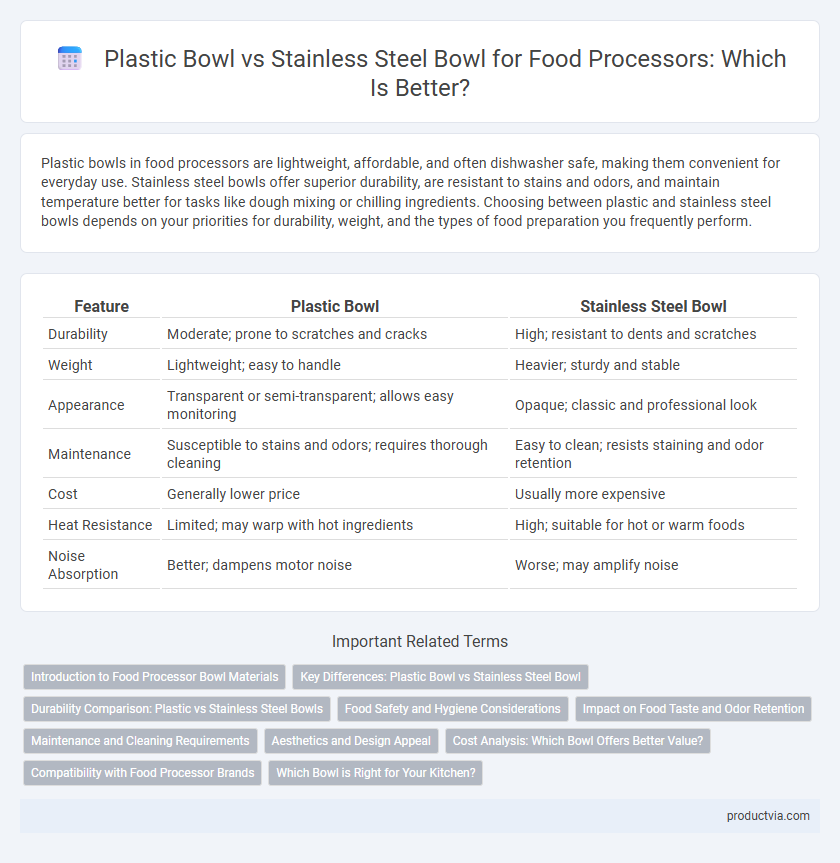Plastic bowls in food processors are lightweight, affordable, and often dishwasher safe, making them convenient for everyday use. Stainless steel bowls offer superior durability, are resistant to stains and odors, and maintain temperature better for tasks like dough mixing or chilling ingredients. Choosing between plastic and stainless steel bowls depends on your priorities for durability, weight, and the types of food preparation you frequently perform.
Table of Comparison
| Feature | Plastic Bowl | Stainless Steel Bowl |
|---|---|---|
| Durability | Moderate; prone to scratches and cracks | High; resistant to dents and scratches |
| Weight | Lightweight; easy to handle | Heavier; sturdy and stable |
| Appearance | Transparent or semi-transparent; allows easy monitoring | Opaque; classic and professional look |
| Maintenance | Susceptible to stains and odors; requires thorough cleaning | Easy to clean; resists staining and odor retention |
| Cost | Generally lower price | Usually more expensive |
| Heat Resistance | Limited; may warp with hot ingredients | High; suitable for hot or warm foods |
| Noise Absorption | Better; dampens motor noise | Worse; may amplify noise |
Introduction to Food Processor Bowl Materials
Food processor bowls primarily come in plastic and stainless steel, each offering distinct advantages in durability and usability. Plastic bowls are lightweight, transparent for easy monitoring, and resistant to dents but may absorb odors or stain over time. Stainless steel bowls provide superior sturdiness, enhanced longevity, and improved resistance to odors and staining, making them ideal for heavy-duty and frequent food processing tasks.
Key Differences: Plastic Bowl vs Stainless Steel Bowl
Plastic bowls for food processors are lightweight, transparent, and often more affordable, allowing users to visually monitor the food while processing. Stainless steel bowls offer superior durability, resistance to stains and odors, and generally support higher speed settings without risk of damage. Choosing between the two depends on preferences for visibility, weight, and long-term durability in food preparation.
Durability Comparison: Plastic vs Stainless Steel Bowls
Stainless steel bowls offer superior durability compared to plastic bowls, resisting scratches, cracks, and stains even with frequent use. Plastic bowls, while lightweight and often more affordable, are prone to wear, discoloration, and potential warping over time. For long-term reliability and maintaining a pristine appearance, stainless steel is the preferred choice in food processors.
Food Safety and Hygiene Considerations
Stainless steel bowls for food processors offer superior food safety due to their non-porous, corrosion-resistant surface that prevents bacterial buildup, unlike plastic bowls which can develop scratches harboring germs. Plastic bowls may retain odors and stains, raising hygiene concerns, especially with acidic or oily foods. Opting for stainless steel ensures easier cleaning and long-term durability, promoting a safer food preparation environment.
Impact on Food Taste and Odor Retention
Plastic bowls in food processors tend to absorb and retain odors and flavors, which can affect the taste of freshly processed ingredients, especially when switching between strong-smelling foods. Stainless steel bowls are non-porous and resistant to staining, ensuring no residual taste or odor transfer, preserving the purity of flavors during food preparation. Choosing stainless steel reduces the risk of cross-contamination of flavors, making it ideal for diverse and flavorful cooking.
Maintenance and Cleaning Requirements
Plastic bowls for food processors are lightweight and resistant to dents but tend to stain easily and may retain odors, requiring frequent thorough cleaning with non-abrasive detergents to maintain hygiene. Stainless steel bowls offer superior durability and resist staining and odor retention, allowing for easier cleaning, often dishwasher-safe and less prone to scratches or discoloration. Choosing stainless steel reduces long-term maintenance efforts and ensures better longevity of the food processor components.
Aesthetics and Design Appeal
Plastic bowls for food processors offer a lightweight, often transparent design that allows users to monitor food progress easily, complementing modern kitchen aesthetics with vibrant or matte finishes. Stainless steel bowls provide a sleek, polished look with a timeless metallic shine that enhances sophisticated kitchen decor and resists staining or discoloration. The choice between plastic and stainless steel bowls ultimately depends on desired visual impact and integration with overall kitchen design themes.
Cost Analysis: Which Bowl Offers Better Value?
Plastic bowls for food processors typically cost 20-40% less than stainless steel counterparts, making them a budget-friendly option for everyday use. Stainless steel bowls offer superior durability and longevity, often resisting stains and odors better, which may reduce replacement costs over time. Evaluating total cost of ownership shows plastic bowls excel in initial savings, while stainless steel bowls provide better value in durability and maintenance.
Compatibility with Food Processor Brands
Plastic bowls for food processors offer greater compatibility across various brands due to their lightweight design and flexible fitting options, making them suitable for models like Cuisinart and Hamilton Beach. Stainless steel bowls, while durable and resistant to staining, often have specific attachment mechanisms that may limit compatibility to certain brands such as KitchenAid or Braun. When choosing between plastic and stainless steel bowls, verifying model-specific compatibility ensures optimal performance and safety during food processing tasks.
Which Bowl is Right for Your Kitchen?
Plastic bowls for food processors offer lightweight convenience and clear visibility, making them ideal for everyday use and easy monitoring of food consistency. Stainless steel bowls provide superior durability, resistance to staining and odors, and often maintain cooler temperatures, perfect for heavy-duty tasks and professional kitchens. Choosing the right bowl depends on prioritizing either the ease of handling and cost-effectiveness of plastic or the long-term resilience and heat resistance of stainless steel.
Plastic bowl vs Stainless steel bowl for food processor Infographic

 productvia.com
productvia.com